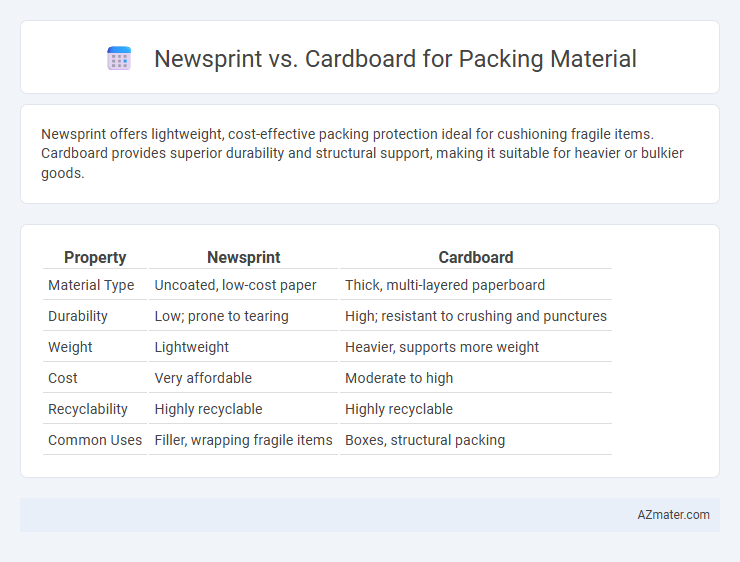Newsprint offers lightweight, cost-effective packing protection ideal for cushioning fragile items. Cardboard provides superior durability and structural support, making it suitable for heavier or bulkier goods.
Table of Comparison
| Property | Newsprint | Cardboard |
|---|---|---|
| Material Type | Uncoated, low-cost paper | Thick, multi-layered paperboard |
| Durability | Low; prone to tearing | High; resistant to crushing and punctures |
| Weight | Lightweight | Heavier, supports more weight |
| Cost | Very affordable | Moderate to high |
| Recyclability | Highly recyclable | Highly recyclable |
| Common Uses | Filler, wrapping fragile items | Boxes, structural packing |
Introduction to Packing Materials: Newsprint vs Cardboard
Newsprint and cardboard serve distinct roles as packing materials based on their structural properties and protective capabilities. Newsprint, composed of thin, flexible paper, excels in cushioning delicate items and filling voids within packages to prevent shifting during shipping. Cardboard, particularly corrugated varieties, offers rigid support and higher durability, making it ideal for forming boxes that safeguard heavier or bulkier contents.
Material Composition: What Are Newsprint and Cardboard?
Newsprint is a low-cost, lightweight paper primarily composed of wood pulp, designed for high-speed printing and newspaper production, containing a high percentage of recycled fibers. Cardboard, often made from thicker and more durable paperboard layers, includes materials such as kraft pulp and recycled fibers, providing greater structural strength for packaging applications. The fundamental difference lies in the fiber density and layering: newsprint is thin and flexible, while cardboard combines multiple layers for rigidity and cushioning in packing materials.
Environmental Impact: Sustainability and Recycling
Newsprint is highly recyclable and decomposes quickly, reducing landfill burden and environmental pollution compared to cardboard, which often contains coatings or adhesives that hinder recycling processes. Cardboard, while bulkier, typically offers greater durability and reuse potential, but its production involves higher resource consumption and carbon emissions due to pulping and processing. Choosing newsprint for packing materials supports sustainability by leveraging a renewable, lightweight, and easily recyclable resource, thereby minimizing overall ecological footprint.
Cost Comparison: Newsprint vs Cardboard
Newsprint is significantly more cost-effective than cardboard, priced at approximately 30-50% less per square foot, making it ideal for budget-sensitive packing needs. Cardboard offers higher durability and protection but comes with increased expenses, averaging $0.10-$0.20 per sheet compared to newsprint's $0.05-$0.10 range. For bulk and lightweight packing, newsprint reduces material costs without sacrificing adequate cushioning, while cardboard demands higher upfront investment for enhanced structural integrity.
Protection and Cushioning Capabilities
Newsprint offers moderate cushioning and is suitable for wrapping lightweight items, providing basic protection against scratches and minor impacts. Cardboard excels in protection and cushioning due to its rigid structure and multi-layered design, effectively absorbing shocks and maintaining shape during transit. For high-impact or fragile shipments, cardboard offers superior durability and impact resistance compared to newsprint.
Durability and Strength in Transit
Newsprint offers limited durability and tensile strength, making it less effective for protecting fragile items during transit compared to cardboard. Cardboard, especially corrugated types, provides superior cushioning and resistance to compression, ensuring better protection against impacts and weight. The structural integrity of cardboard maintains the shape of the package, reducing the risk of damage during handling and shipping.
Weight Considerations for Shipping
Newsprint is significantly lighter than cardboard, making it a preferred choice for packing when minimizing shipping weight is critical. Cardboard offers greater structural strength but adds considerable weight, potentially increasing shipping costs and requiring sturdier handling. Choosing newsprint can reduce overall package weight, leading to lower freight expenses, while cardboard is better suited for heavier or more fragile items requiring extra protection.
Versatility and Use Cases
Newsprint offers exceptional versatility for packing fragile items, providing lightweight cushioning and easy moldability, making it ideal for wrapping glassware, ceramics, and small electronics. Cardboard excels in structural support and durability, suitable for shipping boxes, storage containers, and heavy-duty packaging where protection against impact and stackability is essential. Combining newsprint with cardboard enhances overall packaging efficiency by balancing shock absorption with sturdy containment for diverse shipping requirements.
Availability and Sourcing Options
Newsprint is widely available through local newspaper recycling programs and printing companies, making it an economical and eco-friendly packing material option. Cardboard sourcing is more diverse, with options ranging from retail and wholesale suppliers to recycled corrugated boxes, offering greater structural strength and protection. Both materials benefit from sustainable sourcing, though cardboard's abundant commercial availability enhances scalability for larger packing operations.
Choosing the Right Packing Material: Key Takeaways
Newsprint offers cost-effective, lightweight cushioning ideal for protecting fragile items, whereas cardboard provides superior structural strength for heavy or bulky goods. Selecting the right packing material depends on product weight, fragility, and shipping conditions to ensure optimal protection and cost-efficiency. Businesses prioritize durability and recyclability, making cardboard a preferred choice for long-distance shipping, while newsprint excels in eco-friendly, short-term packaging solutions.

Infographic: Newsprint vs Cardboard for Packing Material
 azmater.com
azmater.com